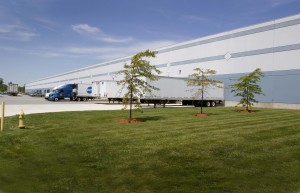
This Littleton distribution center sold in 2018 in a two-property deal for $87.65 million, using financing from State Farm Insurance. Community banks say they have been able to hold their own against national lenders like State Farm. Photo courtesy of JLL
An emerging trend in commercial real estate is putting wind in many banks’ sails despite persistently low interest rates: a growing need for industrial space. As e-commerce increases the demand for these types of facilities, community banks have found they are able to remain competitive even against big, national lenders.
Despite low interest rates pinching community banks’ profits last year, several turned in solid profits in the fourth quarter thanks to strong performance in their commercial lending portfolios.
Eastern Bank reported originating $361 million in commercial real estate loans in the fourth quarter of 2019, while turning in record fourth-quarter profits. Rockland Trust saw its full-year net income up almost 36 percent year-over-year in 2019, in part thanks to commercial loans it acquired when it bought Blue Hills Bank.
Project Size, Location Helps
Massachusetts had $55.691 billion in commercial real estate mortgages originated in 2019, with more than 9,600 transactions compared to $45.4 billion and 9,555 in 2018, according to The Warren Group, publisher of Banker & Tradesman.
More than $7.8 billion of the 2019 activity was in the industrial asset class, including about 300 purchase transactions for $2.58 billion. The previous year had $8.9 billion in industrial activity, with about the same number of purchase transactions for $1.6 billion.
The top 5 industrial lenders by number of loans were local banks, with Rockland Trust and Eastern Bank the top two.
“This is one of the most heavily banked areas, and the level of competition is always very intense. Everyone wants to deploy both debt and equity since it’s one of the hottest markets in the U.S., if not the world.”
— Ian Brandon, head of commercial real estate, Cambridge Savings Bank
“Generally, in Boston and Massachusetts, local and community banks have always had a really active and essential volume of commercial real estate activity, even more so than we see in other markets across the country,” said Heather Brown, executive vice president for CBRE’s capital markets team. “They’ve always been a big component of what we do in commercial real estate.”
E-commerce and the need for last-mile distribution centers have increased the demand both locally and nationally for industrial space in the past couple of years, Brown said.
These transactions are often less than $20 million, Brown added, making them within a comfortable range for community banks to operate. She also saw community banks in 2019 willing to partner with other institutions to secure slightly larger opportunities.
Brown noted that even as she saw more lending by community banks, she did not see banks relaxing their underwriting standards or chasing deals with questionable asset quality.

With companies everywhere engaging in e-commerce, distribution centers have rejuvenated once-tired industrial parks.
‘Intense’ Competition Among Lenders
Even with national real estate investment trusts and other out-of-state investors vying with local money for a chance to invest in Boston’s booming industrial scene, community banks say they have a key edge: the relationships developers and landowners can form with their bankers.
“One of the things we try to do is build on relationships rather than looking at it as a one-off transaction,” said Brian Bullock, chief commercial lending officer and executive vice president with Enterprise Bank in Lowell. “We look for future opportunities to work with these borrowers – opportunities as they renovate – by building that relationship and being very responsive to their needs.”
Relationship–building extends beyond the customer to other community banks as well, Bullock said. As lenders look to offer loans in some of the larger transactions, community banks have joined together to create financing packages. Developing relationships with banks that have consistent underwriting approaches are critical for developing these partnerships.
Ian Brandon, head of commercial real estate at Cambridge Savings Bank, said many of the industrial facilities are outside Boston in areas national lenders and debt sources don’t operate in, making them better suited for community banks. Still, community banks continue to face more competition for these industrial opportunities.
“This is one of the most heavily banked areas, and the level of competition is always very intense,” Brandon said. “Everyone wants to deploy both debt and equity since it’s one of the hottest markets in the U.S., if not the world.”
Relationships a Secret Weapon
Steve Leonard, head of corporate banking for Cambridge Savings Bank, said customers also appreciate the way community banks work with them.

Diane McLauglin
“We recognize that every company hits a bad spot, so we try to work through the problems with those clients,” Leonard said. “People have long memories from 2007 and 2008, and the clients value the local relationship, talking to local decision-makers instead of people in far away offices.”
Much of the industrial loans issued by another top lender, Bristol County Savings Bank, came from its existing customers, said John Silva, the bank’s executive vice president and chief lending officer. He said many of the business owners Bristol lent to saw value in becoming property owners instead of leasing industrial space.
While he occasionally sees larger banks compete in the Bristol County area, most competition is from other community banks.
“The interest rate environment is challenging for the banks right now, and we’re not seeing any let up on the competitor pressures,” Silva said. “You have to pick your spots; you have to know what asset class you like and go with developers you know.”




 |
| 